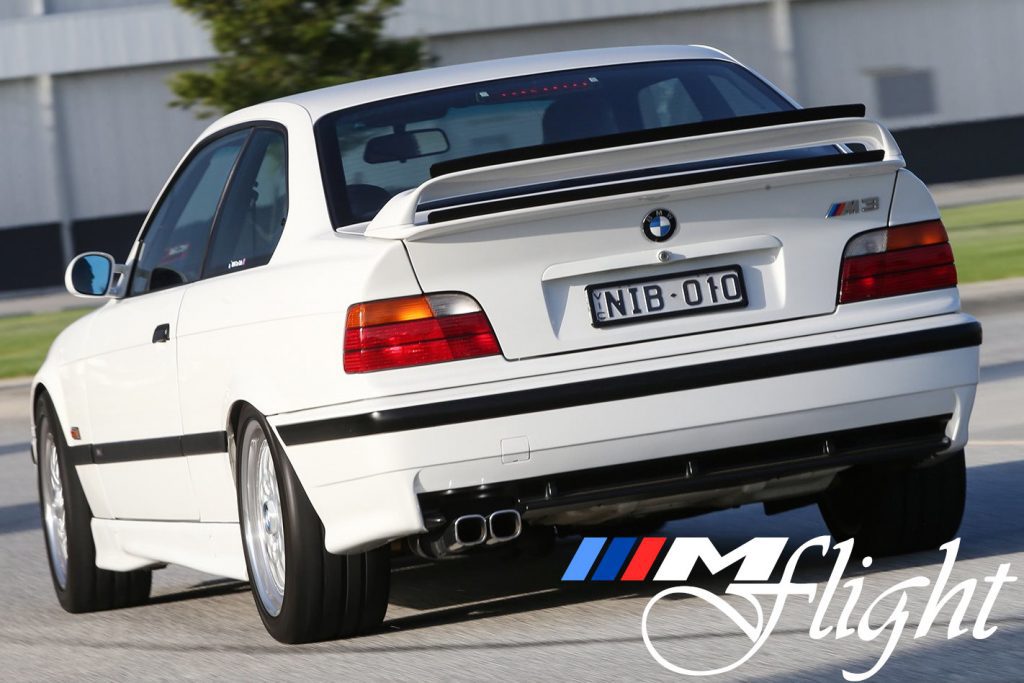The basis was the need to battle Mazda and Porsche on Australian racetracks, which led to the creation of the rarest M3 of all.
With the exception of concepts and one-off curiosities, the rarest M3 was not from Munich, but from Queensland, courtesy of Frank Gardner Racing.
In a joint venture with BMW, Frank Gardner Racing converted the BMW M3s delivered from Munich, all in Alpine White, into the legendary FGR 15 E36 M3 – R in order to homologate the car for local long distance races in Australia.
Porsche found enough customers to justify importing the 911 CS, while Team Sunkworks built the RX-7 SP for Mazda.
Gardner and his crew set out to develop the M3 E36 delivered from Munich into a powerful racing car in order to stand up to the competition. The starting vehicles were standard M3 coupés, where every option was deleted and the change process was tried out: the Gardner team increased performance and reduced weight. The body was stiffened and thrown out what goes. The 2990 cc S50 B30 in-line six-cylinder benefited from new camshafts, a revised intake, optimized exhaust openings, an oil pan with two suction cups and a new control unit, so that the output rose to 239 kW at 7200 rpm and 320 Nm at 3500 rpm . Further down the drivetrain was a lightweight flywheel and the option to use two different clutches depending on whether the car was intended for racing or road use. According to the conversion plan, stronger drive shafts from the 850 Ci and a shorter 3.23: 1 axle drive were used for these 15 cars. However, the BMW Australia maintenance booklet, which lists all M3R parts, does not mention them.
The only color was alpine white and 100 kg was lost because the air conditioning, fog lights, alarm system and the rear seats were removed. The larger front rotors (324mm versus 315mm) were gripped with four-piston calipers using Race-Spec brake pads, there were stiffer springs and shock absorbers, and the adjustable front and rear spoilers were from the M3 GT
Standard wheels were 17 x 7.5-inch front and 17 x 8.5-inch rear, but apparently all cars came with optional 17 x 8.0-inch fronts.
The M3R was priced at $ 189,450, a whopping $ 64,800 more than the normal M3 coupe. It wasn’t faster either, stopping the clocks at 5.74 seconds (0-100 km / h) and 14.02 seconds (0-400 m) compared to 5.69 seconds and 13.96 seconds of the regular car.
Compared to its Mazda and Porsche competitors, the general verdict down under was that the BMW was neither fish nor poultry and was rather compromised compared to the M 3 series because it was not faster because of the price difference rudimentarily justified.
The excitement of settling into Ian Burke’s immaculate M3R cannot be suppressed. The driving position is odd: the steering wheel is too big and not adjustable for the range, and the pedals are far to the right.
There are now only five gear ratios left, but the E30 Long Throw has been replaced with a much closer gearbox, and the standard racing clutch has thankfully been swapped out for a more progressive element.
It’s probably more amusing to think that this car is the M3 CSL or GTS of its time, as it feels extremely civilized. The only proof of the connection to motorsport is the squeaking of the brake pads. The ride is smooth and the engine is much less noisy than in later models. Less loud but no less brilliant; The whole car is so fluid and incredibly responsive.
Like the E30 in the past, the M3R feels absolutely stable on all four tires and quickly creates self-confidence, although the steering does not provide as precise feedback as would actually be expected and desirable. The oversized steering wheel also shrinks the initial response times very quickly.
In general, however, the E36 brought the M3 mainstream, without question. There was also a sedan for those who missed four doors and a convertible for those who completely missed the point. In 1995, BMW presented the revised E36 M3, which had a 3201 cc engine with 236 kW / 350 Nm, a revised chassis (with faster steering!), And the option of an SMG transmission with the BMW making the 1997 MOTOR title Performance Car of the Year.





